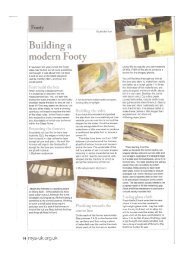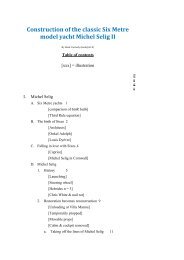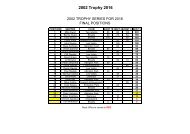Michel Selig II
The Construction of The Classic Six Metre Model Yacht Michel Selig II
The Construction of The Classic Six Metre Model Yacht Michel Selig II
Create successful ePaper yourself
Turn your PDF publications into a flip-book with our unique Google optimized e-Paper software.
Aft view of two pairs of half lifts being glued together.<br />
One can see the nails blocking the wedges.<br />
5. Upper part of the hull<br />
The upper part of hull consists of the seven lifts glued<br />
together.<br />
Gluing the two lowest lifts together<br />
My collection of wood clamps was insufficient for gluing<br />
together the upper lifts, which are the longest, using them<br />
alone. I had recourse to 3 kg. lead ingots and masons'<br />
clamps.<br />
For the ingots to squeeze correctly, it was necessary to place<br />
a support under the lifts where the ingots were placed.<br />
Before clamping, I placed the ingots in place. Their weight<br />
stabilised the structure, preventing it from shifting as I<br />
placed the clamps.<br />
The centre of gravity of the masons' clamps is not in line<br />
with where the pressure is being applied to the lifts. This<br />
gives them the tendency rotate out of the vertical, thus<br />
placing a twisting force on the lifts. To avoid this, they<br />
were placed next to the lead ingots which helped the lifts<br />
resist the twisting force<br />
Gluing the two top lifts together. Note<br />
the lead ingots and the masons' clamps.<br />
As the upper part of the hull narrowed, it was no longer<br />
possible to place the clamps directly on the lifts. Bridges







